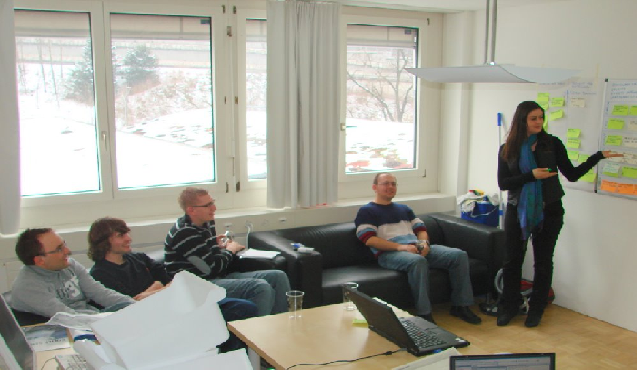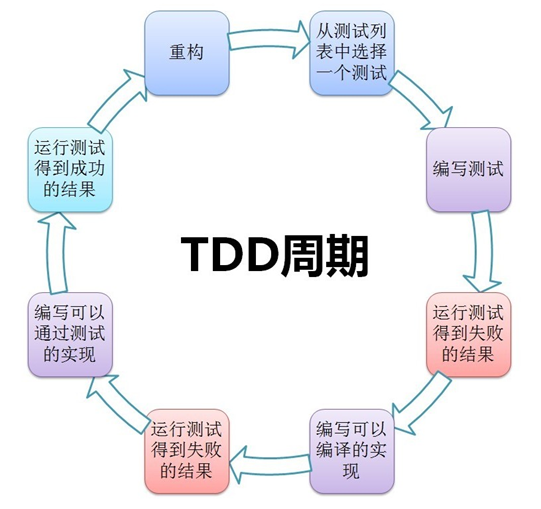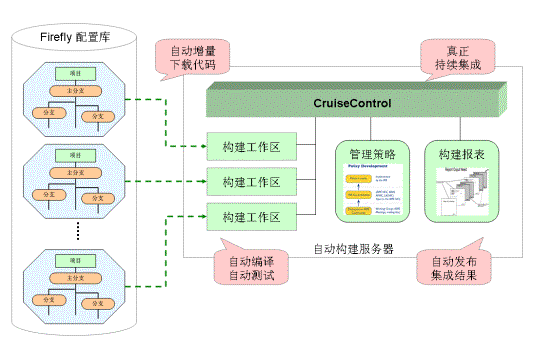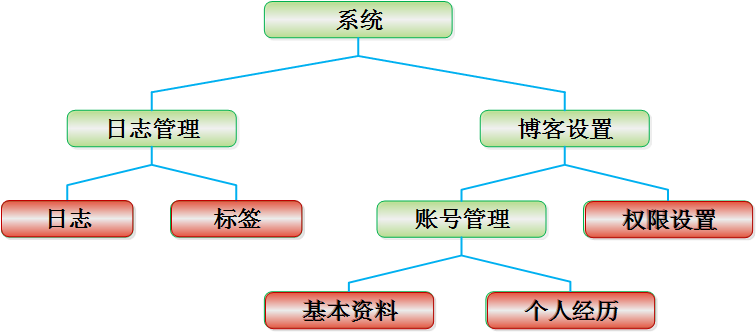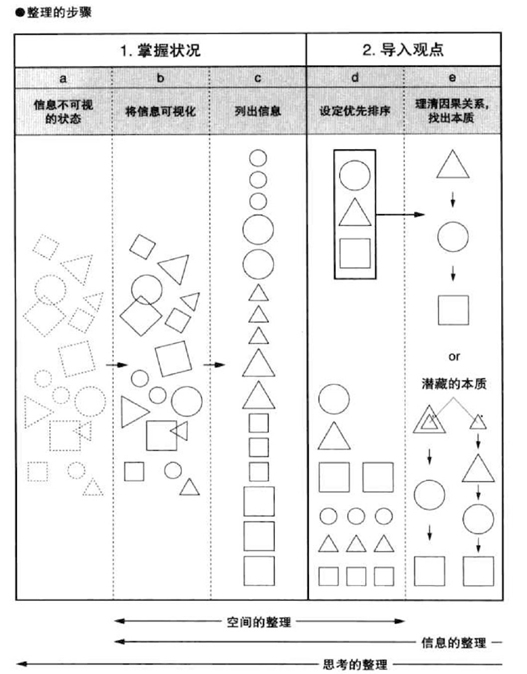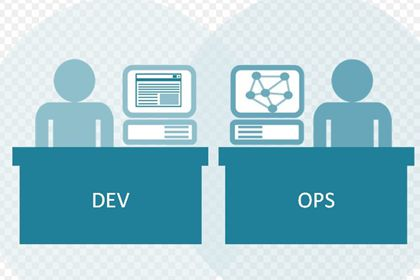|
|
敏捷軟件開發(fā) Agile software Development
敏捷開發(fā)是一種軟件開發(fā)方法,基于迭代和增量開發(fā),通過自組織,跨團隊,溝通協(xié)作完成開發(fā)工作。
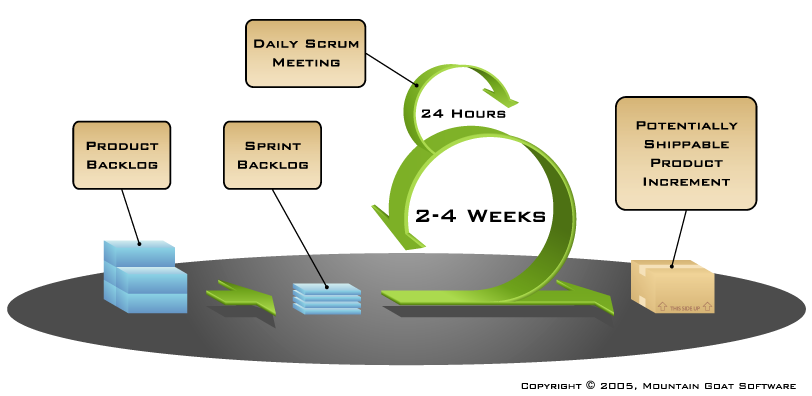 敏捷宣言的誕生:
敏捷宣言的誕生:
2001年2月11日到13日,17位軟件開發(fā)領(lǐng)域的領(lǐng)軍人物聚集在美國猶他州的滑雪勝地雪鳥(Snowbird)雪場。經(jīng)過兩天的討論,“敏捷”(Agile)這個詞為全體聚會者所接受,用以概括一套全新的軟件開發(fā)價值觀。這套價值觀,通過一份簡明扼要的《敏捷宣言》,傳遞給世界,宣告了敏捷開發(fā)運動的開始。
敏捷軟件開發(fā)宣言
我們一直在實踐中探尋更好的軟件開發(fā)方法,身體力行的同時也幫助他人。由此我們建立了如下價值觀:
個體和互動 高于 流程和工具
工作的軟件 高于 詳盡的文檔
客戶合作 高于 合同談判
響應(yīng)變化 高于 遵循計劃
也就是說,盡管右項有其價值,我們更重視左項的價值。
We are uncovering better ways of developing software by doing it and helping others do it. Through this work we have come to value:
Individuals and interactions over processes and tools
Working software over comprehensive documentation
Customer collaboration over contract negotiation
Responding to change over following a plan
That is, while there is value in the items on the right, we value the items on the left more.
敏捷開發(fā)的12條準(zhǔn)則:
準(zhǔn)則1:Our highest priority is to satisfy the customer through early and continuous delivery of valuable software.
我們的最高目標(biāo)是,通過盡早和持續(xù)地交付有價值的軟件來滿足客戶。
準(zhǔn)則2:Welcome changing requirements, even late in development. Agile processes harness change for the customer's competitive advantage.
歡迎對需求提出變更——即使是在項目開發(fā)后期。要善于利用需求變更,幫助客戶獲得競爭優(yōu)勢。
準(zhǔn)則3:Deliver working software frequently, from a couple of weeks to a couple of mouths, with a preference for the shorter timescale.
要不斷交付可用的軟件,周期從幾周到幾個月不等,且越短越好。
準(zhǔn)則4:Business people and developers must work together daily throughout the project.
項目過程中,業(yè)務(wù)人員與開發(fā)人員必須在一起工作。
準(zhǔn)則5:Build projects around motivated individuals. Give them the environment and support they need, and trust them to get the job done.
要善于激勵項目人員,給他們以所需要的環(huán)境和支持,并相信他們能夠完成任務(wù)。
準(zhǔn)則6:The most efficient and effective method of conveying information to and within a development team is face-to-face conversation.
無論是團隊內(nèi)還是團隊間,最有效的溝通方法是面對面的交談。
準(zhǔn)則7:Working software is the primary measure of progress.
可用的軟件是衡量進度的主要指標(biāo)。
準(zhǔn)則8:Agile processes promote sustainable development. The sponsors, developers, and users should be able to maintain a constant pace indefinitely.
敏捷過程提倡可持續(xù)的開發(fā)。項目方、開發(fā)人員和用戶應(yīng)該能夠保持恒久穩(wěn)定的進展速度。
準(zhǔn)則9:Continuous attention to technical excellence and good design enhances agility.
對技術(shù)的精益求精以及對設(shè)計的不斷完善將提升敏捷性。
準(zhǔn)則10:Simplicity -- the art of maximizing the amount of work not done -- is essential.
要做到簡潔,即盡最大可能減少不必要的工作。這是一門藝術(shù)。
準(zhǔn)則11:The best architectures, requirements, and designs emerge from self-organizing teams.
最佳的架構(gòu)、需求和設(shè)計出自于自組織的團隊。
準(zhǔn)則12:At regular intervals, the team reflects on how to become more effective, then tunes and adjusts its behavior accordingly.
團隊要定期反省如何能夠做到更有效,并相應(yīng)地調(diào)整團隊的行為。
敏捷方法 Agile
Scrum:http://zh.wikipedia.org/wiki/Scrum
Scrum Role 角色
Product Owner, Team, ScrumMaster, Chicken and the Pig
產(chǎn)品經(jīng)理,團隊,ScrumMaster,雞和豬,有一則小故事
Scrum Meetings
Sprint 計劃會議 Sprint Planning Meeting
需求澄清,確定那些用戶故事需要在接下來的迭代里完成
根據(jù)Product Owner制定的產(chǎn)品或項目計劃在Sprint的開始時做準(zhǔn)備工作。
他要準(zhǔn)備一個根據(jù)商業(yè)價值排好序的客戶需求列表。這個列表就是Prodct Backlog[需求池],一個最終會交付給客戶的產(chǎn)品特性列表,它們根據(jù)商業(yè)價值來排列優(yōu)先級。
商業(yè)價值"公式":As a <type of user> I want <some functionality> so that <some benefit>
在會議上每個團隊成員回答三個問題(During the meeting, each team member answers three questions)
1. 昨天你完成了那些工作?(What have you done since yesterday?)
2. 今天天你打算做什么?(What are you planning to do today?)
3. 完成你的目標(biāo)是否存在障礙?(Do you have any problems that would prevent you from accomplishing your goal?)
會議準(zhǔn)時舉行(The meeting starts precisely on time.)
任何人都可以參加,,但只有團隊內(nèi)部人員發(fā)言(All are welcome, but normally only the core roles speak.)
會議時長限制為15分鐘(The meeting is timeboxed to 15 minutes.)
會議時間地點應(yīng)該固定(The meeting should happen at the same location and same time every day)
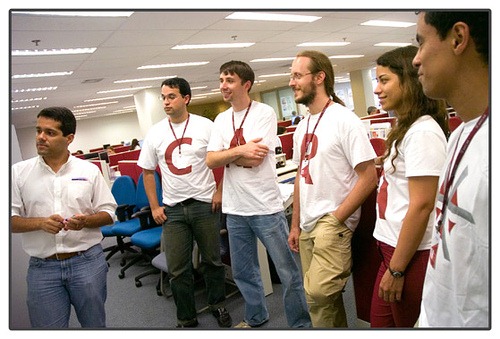 評審會議(Sprint Review Meeting)
評審會議(Sprint Review Meeting)
評審會議在每個迭代結(jié)束后舉行,在會議上團隊演示此次迭代中完成了那些工作,一般會有相關(guān)的DEMO演示。
At the end of each sprint a sprint review meeting is held. During this meeting the Scrum team shows what they accomplished during the sprint. Typically this takes the form of a demo of the new features.
這個會議演示的內(nèi)容應(yīng)該是啟動會議上確定的那些內(nèi)容
During the sprint review the project is assessed against the sprint goal determined during the Sprint planning meeting
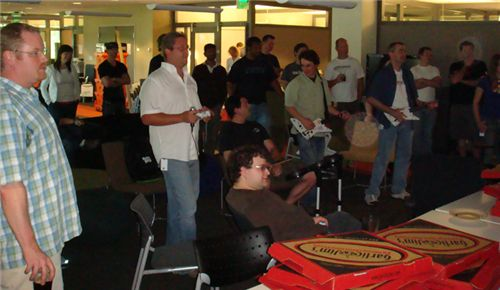 回顧會議(Sprint Retrospective Meeting)
回顧會議(Sprint Retrospective Meeting)
沖刺回顧會議一般限時為3個小時(The sprint retrospective meeting is timeboxed to 3 hours.)
僅團隊成員參加,產(chǎn)品經(jīng)理和ScrumMaster,產(chǎn)品經(jīng)理選擇性參加(It is attended only by the team, the scrum master and the product owner. The product owner is optional.)。
會議上團隊中每個成員需要回答兩個問題(Start the meeting by having all team members answer two questions):
1. 此次沖刺中那些地方做得好?(What went well during the sprint?)
2. 下個迭代中那些地方可以改進? (What could be improved in the next sprint?)
scrum master記錄每個成員的答案(The scrum master writes down the team’s answers in summary form)。
團隊為這些改進意見評定優(yōu)先級(The team prioritizes in which order it wants to talk about the potential improvements)。
scrum master在回顧會議中不允許給出答案,但要鼓勵成員自己找到較好的辦法(The scrum master is not in this meeting to provide answers, but to facilitate the team’s search for better ways for the scrum process to work for it)。
這些改進工作可以添加至下個迭代中,作為一個非功能性工作,回顧會議最不擔(dān)心的就是變化(Actionable items that can be added to the next sprint should be devised as high-priority non functional product backlog. Retrospectives that dont result in change are sterile and frustrating.)。
 測試驅(qū)動開發(fā)(TDD/Test-Driven Development)
測試驅(qū)動開發(fā)(TDD/Test-Driven Development)
測試驅(qū)動開發(fā)不是指測試人員驅(qū)動開發(fā)人員搞開發(fā),一開始我真這么認為了,實際上測試驅(qū)動開發(fā)指以測試用例為出發(fā)點,不寫一行代碼的情況下,編寫單元測試,從而無法通過,然后開始編寫代碼使之通過測試。這樣做的好處是直指目標(biāo),達到目標(biāo)被視為最高優(yōu)先級,TDD的執(zhí)行離不開重構(gòu),因為這種開發(fā)方式完全漠視設(shè)計。所以設(shè)計在開始時一定很差,通過不斷的重構(gòu)達到最優(yōu)的代碼,絕不會過度設(shè)計,也不會做偏。網(wǎng)上多半會說實踐后你會喜歡上它,它的大概流程如下圖所示:
XP是一個輕量級的、靈巧的軟件開發(fā)方法;同時它也是一個非常嚴謹和周密的方法。它的基礎(chǔ)和價值觀是交流、樸素、反饋和勇氣。即任何一個軟件項目都可以從四個方面入手進行改善:加強交流;從簡單做起;尋求反饋;勇于實事求是。XP是一種近螺旋式的開發(fā)方法,它將復(fù)雜的開發(fā)過程分解為一個個相對比較簡單的小周期;通過積極的交流、反饋以及其它一系列的方法,開發(fā)人員和客戶可以非常清楚開發(fā)進度、變化、待解決的問題和潛在的困難等,并根據(jù)實際情況及時地調(diào)整開發(fā)過程。
結(jié)隊編程Paring Program -即時反饋
http://kb.cnblogs.com/page/91650/
http://www.blogJava.NET/moxie/archive/2006/09/14/69714.html
流模式(Flow)——兩個程序員共同從事一個有趣又有挑戰(zhàn)性的問題。
指導(dǎo)模式(Coaching)——老練的程序員在解決問題方面有經(jīng)驗和知識,可以與其他不能有效地獨自解決問題的程序員分享。
非常軟的軟廣告:國產(chǎn)開源敏捷工具 - fKanban
http://www.cnblogs.com/a311300/archive/2010/11/18/1880776.html
ToDo, OnGoing, Done, Impediment
敏捷估算撲克 - 合理的任務(wù)分解
http://community.techexcel.com.cn/010DevSuite/070Agile_Scrum/010Posts/010Agile_Poker
http://www.csaipm.com/cost/201005101141211188.htm
敏捷方法中的估算應(yīng)該是由團隊成員共同進行,而不是由項目經(jīng)理“閉門造車”式地得出。這樣做的原因之一是因為開發(fā)團隊是由不同經(jīng)驗的同事組成,對于同一個問題,經(jīng)驗不同的人往往會給出不一樣的解決方案。如果可以將所有人的能力集中到一起,那么最后對問題的求解也就八九不離十了。
 持續(xù)集成(Continuous Integration)- 團隊協(xié)作的基礎(chǔ)
持續(xù)集成(Continuous Integration)- 團隊協(xié)作的基礎(chǔ)
http://blog.csdn.NET/tony1130/article/details/1876819
http://www.hansky.com.cn/cn/dokuwiki/doku.php/corp/case/digitalchina
什么是持續(xù)集成(Continuous Integration)?
這個名詞已經(jīng)在軟件開發(fā)領(lǐng)域持續(xù)了N年,一個比較簡單的定義如下:
持續(xù)集成(CI)是一種實踐,可以讓團隊在持續(xù)發(fā)布的基礎(chǔ)上收到反饋并進行改進,不必等到開發(fā)周期后期才尋找和修復(fù)缺陷。
http://www.hudong.com/wiki/%E5%8D%95%E5%85%83%E6%B5%8B%E8%AF%95
單元測試(模塊測試)是開發(fā)者編寫的一小段代碼,用于檢驗被測代碼的一個很小的、很明確的功能是否正確。通常而言,一個單元測試是用于判斷某個特定條件(或者場景)下某個特定函數(shù)的行為。
敏捷測試 Agile Test
http://subject.csdn.NET/agile-testing.htm
所謂敏捷測試,就是指測試遵循敏捷宣言進行,把開發(fā)作為顧客看待。與敏捷宣言中的“個體和交互比過程和工具更有價值”一樣強調(diào)人的作用。
代碼重構(gòu)(Reconstruction)
Duplicated Code(重復(fù)代碼)
Long Method(過長函數(shù))
Large Class(過大的類)
Long Parameter List(過長參數(shù)列)
Divergent Change(發(fā)散式變化)
Shotgun Surgery(霰彈式修改)
Feature Envy(依戀情結(jié))
Data Clumps(數(shù)據(jù)泥團)
Primitive Obsession(基本類型偏執(zhí))
Switch Statements(switch驚悚現(xiàn)身)
Parallel InheritanceHierarchies(平行繼承體系)
Lazy Class(冗贅類)
Speculative Generality(夸夸其談未來性)
Temporary Field(令人迷惑的暫時字段)
Message Chains(過度耦合的消息鏈)
Middle Man(中間人)
Inappropriate Intimacy(狎昵關(guān)系)
Alternative Classes with Different Interfaces(異曲同工的類)
Incomplete Library Class(不完美的庫類)
Data Class(純稚的數(shù)據(jù)類)
Refused Bequest(被拒絕的遺贈)
Comments(過多的注釋)
Extract Method(提煉函數(shù))
Inline Method(內(nèi)聯(lián)函數(shù))
Inline Temp(內(nèi)聯(lián)臨時變量)
Replace Temp with Query(以查詢?nèi)〈R時變量)
Introduce Explaining Variable(引入解釋性變量)
Split Temporary Variable(分解臨時變量)
Remove Assignments to Parameters(移除對參數(shù)的賦值)
Replace Method with Method Object(以函數(shù)對象取代函數(shù))
Substitute Algorithm(替換算法)
Move Method(搬移函數(shù))
Move Field(搬移字段)
Extract Class(提煉類)
Inline Class(將類內(nèi)聯(lián)化)
Hide Delegate(隱藏"委托關(guān)系")
Remove Middle Man(移除中間人)
Introduce Foreign Method(引入外加函數(shù))
Introduce Local Extension(引入本地擴展)
Self Encapsulate Field(自封裝字段)
Replace Data Value with Object(以對象取代數(shù)據(jù)值)
Change Value to Reference(將值對象改為引用對象)
Change Reference to Value(將引用對象改為值對象)
Replace Array with Object(以對象取代數(shù)組)
Duplicate Observed Data(復(fù)制"被監(jiān)視數(shù)據(jù)")
Change Unidirectional Association to Bidirectional(將單向關(guān)聯(lián)改為雙向關(guān)聯(lián))
Change Bidirectional Association to Unidirectional(將雙向關(guān)聯(lián)改為單向關(guān)聯(lián))
Replace Magic Number with Symbolic Constant(以字面常量取代魔法數(shù))
Encapsulate Field(封裝字段)
Encapsulate Collection(封裝集合)
Replace Record with Data Class(以數(shù)據(jù)類取代記錄)
Replace Type Code with Class(以類取代類型碼)
Replace Type Code with Subclasses(以子類取代類型碼)
Replace Type Code with State/Strategy(以State/Strategy取代類型碼)
Replace Subclass with Fields(以字段取代子類)
Decompose Conditional(分解條件表達式)
Consolidate Conditional Expression(合并條件表達式)
Consolidate Duplicate Conditional Fragments(合并重復(fù)的條件片段)
Remove Control Flag(移除控制標(biāo)記)
Replace Nested Conditional with Guard Clauses(以衛(wèi)語句取代嵌套條件表達式)
Replace Conditional with Polymorphism(以多態(tài)取代條件表達式)
Introduce Null Object(引入Null對象)
Introduce Assertion(引入斷言)
Rename Method(函數(shù)改名)
Add Parameter(添加參數(shù))
Remove Parameter(移除參數(shù))
Separate Query from Modifier(將查詢函數(shù)和修改函數(shù)分離)
Parameterize Method(令函數(shù)攜帶參數(shù))
Replace Parameter with Explicit Methods(以明確函數(shù)取代參數(shù))
Preserve Whole Object(保持對象完整)
Replace Parameter with Methods(以函數(shù)取代參數(shù))
Introduce Parameter Object(引入?yún)?shù)對象)
Remove Setting Method(移除設(shè)值函數(shù))
Hide Method(隱藏函數(shù))
Replace Constructor with Factory Method(以工廠函數(shù)取代構(gòu)造函數(shù))
Encapsulate Downcast(封裝向下轉(zhuǎn)型)
Replace Error Code with Exception(以異常取代錯誤碼)
Replace Exception with Test(以測試取代異常)
Pull Up Field(字段上移)
Pull Up Method(函數(shù)上移)
Pull Up Constructor Body(構(gòu)造函數(shù)本體上移)
Push Down Method(函數(shù)下移)
Push Down Field(字段下移)
Extract Subclass(提煉子類)
Extract Superclass(提煉超類)
Extract Interface(提煉接口)
Collapse Hierarchy(折疊繼承體系)
Form Tem Plate Method(塑造模板函數(shù))
Replace Inheritance with Delegation(以委托取代繼承)
Replace Delegation with Inheritance(以繼承取代委托)
Tease Apart Inheritance(梳理并分解繼承體系)
Convert Procedural Design to Objects(將過程化設(shè)計轉(zhuǎn)化為對象設(shè)計)
Separate Domain from Presentation(將領(lǐng)域和表述/顯示分離)
Extract Hierarchy(提煉繼承體系)
代碼Review
不想重復(fù)說了,同單元測試一樣重要。
以上是個人經(jīng)過理論學(xué)習(xí),實踐檢驗后總結(jié)的一篇文章,其中大部分觀點、素材皆來自網(wǎng)絡(luò)和公司敏捷活動中所得。我想要說的是,我是支持這些觀點的,我認為這些方法論可以很好的指導(dǎo)日常開發(fā)工作,能夠解決實際問題,That's All。
it知識庫:敏捷軟件開發(fā) Agile Software Development,轉(zhuǎn)載需保留來源!
鄭重聲明:本文版權(quán)歸原作者所有,轉(zhuǎn)載文章僅為傳播更多信息之目的,如作者信息標(biāo)記有誤,請第一時間聯(lián)系我們修改或刪除,多謝。
